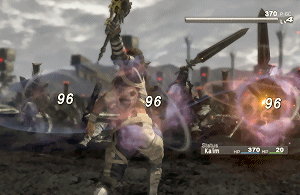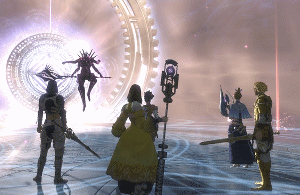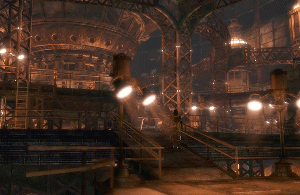
Review: Lost Odyssey

J-RPG/Adventure/Strategy
Our *random battle* review of the new *random battle* RPG for the Xbox *random battle* 360.
![]()
Colin
Hironobu Sakaguchi has made several games that I would place in my top ten and after giving the world Final Fantasy, it’s no surprise that I will make more than a few comparisons between this game and his past work. And so it begins…
Ok, perhaps to understand the ramblings in this review a brief history of the reviewer (moi) and RPG’s is in order. FF 7 is the best evar (why I oughta.. – Ed). FF 8 and 9 were also good. FF10 was fantastic. FF10-2 (lol @). FF11 was an online RPG (lols). FF12 had a great combat system but a non-compelling story. Many other previous FF games – I “heartâ€. Of course I love many non FF RPG’s too – The Zeldas, Vagrant Story, Dragon Quest, Pokemon (yeah, it counts) etc and many modern action RPG’s, KOTOR, Mass Effect, Fable etc. In short, I enjoy a good Role Playing Game of any kind… but I can’t really commit to the online ones yet(Two Worlds? – Ed)..

Skynet gets a kicking.
The factors which make a good RPG are enjoyable dialogue, compelling story, interesting characters, varied locales and a musical score to make your heart melt. If this is what you look for then what are you still doing here? This game ticks all the boxes.
I’m not going to say much about the story. What’s the point? A story is best for an individual to discover as they play through, rest assured that it involves plenty of love, loss, war, betrayal and magic. I will however say that it is well thought out, twisting, thought provoking and will keep you wondering until you get some answers.
The game starts with an epic battle (and stunning FMV to boot) and before long you are dropped into your first turn-based battle. From here you begin your journey to uncover a conspiracy in the world which unsurprisingly involves magic and an OTT bad dude. Along the way you meet companions who join you for their own personal reasons which pretty much leads to everyone being on a journey of self discovery, primarily in the case of the immortals with them seeking their lost memories.

Don't cross the streams!
First thing to note is just how damn pretty this game is. During the game’s opening you go quite seamlessly from the stunning FMV to the in-game graphics and from here into the actual battle mode, which itself has been distilled to purity. All characters have just a weapon slot, a ring slot (for adding elemental/status effects to you attacks) and an accessory slot (for learning new abilities/immunities). All characters “level up†in the traditional way (experience from battles) which earns them increased attack/defence/health attributes.
The differences between the mortals and immortals are that they both have their own ways of learning skills. Again mortals follow the more traditional path, earn EXP > level up > gain new abilities/skills/immunities at set levels. In short you have no control over mortal abilities from level 1 up to 50+. It’s with the immortals that you can be creative. Immortals learn skills either from equipping accessories or linking them with a mortals learned skills, until the immortal permanently learns them. Effectively any skill a mortal has any of the immortals can learn. Once an immortal learns a skill they have to equip it to use it, and they only have so many slots these skills can be equipped into, although new slots for the immortals can be added as you play through the game (geeky stat based RPG stuff over).

we ain't got no entertainment center, no climate control, no video system, no surveillance, no freezers, no fucking ice cream, no rubbers, no women, no guns. All we got here is *shit*!
So while having a party full of immortal people whom when KO’d will auto-revive after a few turns may sound like a good idea (unless all are KO’d at once) you wont really be gaining any new abilities without mortals. Balance is as always the name of the game.
Kaim is very much a standard J-RPG lead character. The strong and silent type but also a pretty boy, borderline androgynous who wears clothes that quite frankly look a bit gimpy – exposing his toned smooth belly… Initially it’s not easy to feel anything for this guy, his actions are all very “stiff upper lip†and when he does try to emote it can seem a bit wooden, but that’s ok he is “the strong leadâ€. Where Kaim’s character shines through is during the “Thousand Years of Dreams†sequences. These occur either during the story, or when you find them during a bit of exploration on your travels, they appear as flashbacks to Kaim’s past, memories that he is slowly uncovering, and are in the form of a text story that can be over 12 pages long. They can tell of anything ranging from past battles to friends and loves. The emotions that these stories trigger can be quite powerful (just search for Elegy Island on youtube). Some would say they may break up the flow of what you’re doing (sometimes occurring during a task you have to accomplish), but that’s why they don’t have to be read at the time – they’re saved for later. The stories add depth that I haven’t seen in quite some time and it really was a bold move to include these text heavy stories.
|
Steve Secondary Review There hasn’t been much evolution to the Japanese RPG formula for quite some time now. FFXII tried to evolve the system with a new combat mechanic and radically different story arc, and whilst this won over many critics it left a lot of fans a bit cold. The good, or bad news, is that Lost Odyssey is as traditional as it gets. The story is the normal yarn of amnesiac heroes fighting their way across a world map to kill an evil person who previously wronged them. Where this game excels is in the refinements it has made to the genre. The story is told with memory flashbacks shown as book sections, these are exceptionally well-written and are genuinely emotionally touching in places. The combat has a neat conceit in that because you are immortal if you die you re-spawn after 3 turns, and also includes a rhythm element to your attacks which can be used to increase the damage. Mistwalker have made the conscious decision to simplify the equipment choices you have, but then within this limited system there are endless permutations and the way in which you can select to learn new skills adds immeasurably to the customisation of your immortal characters. Finally there is the revolutionary experience system, which is built to ensure there is no need to grind. It rewards you heavily until you reach the ideal level for that dungeon, then the exp you receive dramatically drops down. A true breath of fresh air in comparison to EXP-grinding system of most other RPGS. In summary an excellently realised game with some stunning revisions to the genre, while not evolutionary it’s certainly exceptional. Secondary Score: 9/10 |
The other characters in the game aren’t fleshed out quite so much but this is because all of their character is pretty much well defined within the first five minutes of meeting them. Notable examples are Cooke and Mack, two children who basically add some much needed naivety and innocence to the world of monsters and impending war around them – always enjoyable to hear their dialogue. Of course probably the greatest thing about this game is the character of Jansen Friedh. The quintessential drunk, joker, comic relief, self centred, egotistical ladies man that is missing from so many games these days. You just know that you will laugh.
With so many great things about this game it is very easy to ignore the negatives. In order to keep things as balanced as possible they do have to be mentioned.
The load times – OH GOD the load times. Specifically for me the battle load times were the worst. Depending on the area/battle the load time will vary. Starting from – the field screen going all wobbly > panning across the battle arena > panning across each of your characters (one of them may say something) the others will twiddle their weapons > seeing the enemies > starting the battle – times vary from 15 to 20 seconds. When you actually realise that this is an RPG… A traditional Japanese RPG… A traditional old school Japanese RPG with random battles most definitely the order of the day, these battle load times do tend to grate on the soul a little.
Other minor annoyances include. During cinematic sequences frequently you are required to press A once one character has finished talking to either hear their next line or hear what the next person has to say – kinda breaks the cinematic feel. It’s not always perfectly clear where you have to go/do – I would have thought a quest book was common place in most RPGs by now. However, Lost Odyssey also has some nice minor touches. Having a sprint button. The way Kaim’s head will turn in the field if he sees something useful. Automatic checkpoints before boss battles make for easy retry-age. The fact that I haven’t had to grind at all. The ability to warp to different places on the map etc.
This game is as compelling as it is beautiful and if you can let the technical issues go (believe me, I could very easily) then you will find a greatly enjoyable game that will make you think, laugh and feel emotions that you’ve not had to use while gaming since… well, that’s up to you.
Games can’t be art? Sod off
Rating: 









8/10
